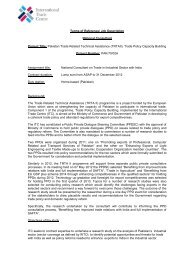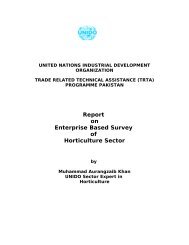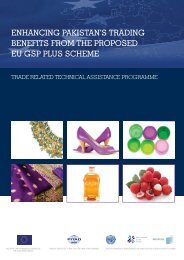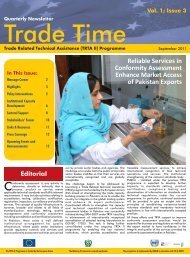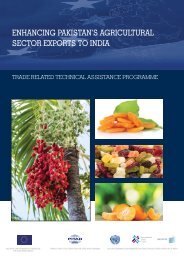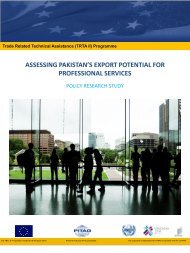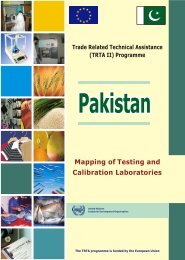Enhancing dairy sector export competitiveness - International Trade ...
Enhancing dairy sector export competitiveness - International Trade ...
Enhancing dairy sector export competitiveness - International Trade ...
You also want an ePaper? Increase the reach of your titles
YUMPU automatically turns print PDFs into web optimized ePapers that Google loves.
ENHANCING DAIRY SECTOR EXPORT COMPETITIVENESS IN PAKISTANEven if the farmers and other stakeholders working in the <strong>dairy</strong> <strong>sector</strong> know about the credit schemes, theyavoid availing them due to lengthy and cumbersome loaning procedures including processing time as wellas documentary requirements. High mark up on the credit facilities is yet another impediment in provisionof financial facility to the farmers.It has also been reported that the outreach of the Micro Finance Banks (MFBs) and Micro FinancialInstitutions (MFIs) is either inefficient or the supply of credit is inadequate to meet the original financialrequirements of the farmers’ community. The operating costs of farmers get to as higher as 22% perannum in the <strong>dairy</strong> <strong>sector</strong>. This generally makes micro finance a little attractive and les viable option andtherefore a large number of farmers cannot avail the facility.Measures AdoptedCurrently 26 commercial and microfinance banks are operating in Pakistan through their branch networkbase of more than 3,900 designated branches for agricultural credit purpose. These financial institutionsprominently include Allied Bank Limited (ABL), Habib Bank Limited (HBL), Muslim Commercial Bank(MCB), United Bank Limited (UBL), two specialized banks i.e. Zarai Taraqiati Bank Limited (ZTBL), PunjabProvincial Corporative Bank Limited (PCBL) and 14 private domestic banks. Furthermore, fivemicrofinance banks (MFBs) are also providing financing to the farmers. Amongst other agriculturalactivities, livestock farming is also covered under certain financing schemes.Impact AssessmentThe total amount of funds for the agriculture credit disbursement increased to PKR 285 billion in 2011-12,as compared to PKR 263 billion in the preceding year. More than 65% of the total credit disbursement wasmade to the farm <strong>sector</strong>, including livestock and <strong>dairy</strong>, which was higher than the previous year. However,small farmers face difficulty in receiving credit from the mainstream financial institutions due to the inabilityof securing them through “collateral”, an explicit guarantee that is required by the banks to off-set the riskassociated with lending. Since small farmers do not usually own any such guarantee or security, theyremain outside the net of potential borrowers.Recommendationsa. The State Bank of Pakistan should instruct the banking <strong>sector</strong> to launch facilitation desks at allthe branches offering credit schemes for the <strong>dairy</strong> and livestock <strong>sector</strong> (mainly covered underagricultural credit). Besides, other branches and banks not offering agricultural credit facilitiesshould also be equipped with proper information so that a maximum number of people areapproached and provided information on the agricultural credit schemes offered by certainfinancial institutions in the public as well as the private <strong>sector</strong>. Media campaign (electronic andnewspapers) can also help in spreading information in the farmers’ community. People shouldbe able to know the cost and benefits of availing a financial facility so that no deceptivemarketing should be able to deceive them.b. Easy and timely access to loans needs to be ensured to small farmers who are mostly illiterateand do not own any guarantees that can be used as collateral. The credit schemes for thesefarmers should be on the same footing as these are for the medium and large-scale farmers.Investment RegulationsAs per government and industry sources, the <strong>dairy</strong> <strong>sector</strong> in Pakistan is likely to witness major investmentsin the near future, especially in the areas of corporate farming by large businessmen who are looking todiversify their existing enterprises. Emerging corporate farms are large in size, comprising of 1,000 to2,500 milch animals in their herds. These animals have been imported mainly from Australia, Denmark andSweden due to the reason that these carry 4-5 times more productivity as compared to the local breeds.Thus the much higher rates of return offered by the <strong>dairy</strong> <strong>sector</strong> has served as a major attraction for thelocal investors to adopt <strong>dairy</strong> farming business.85



